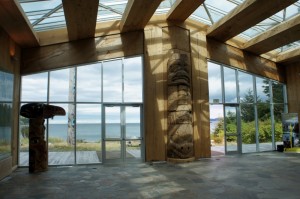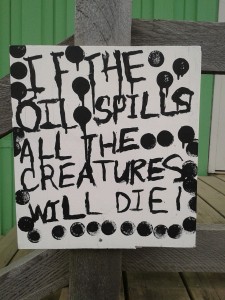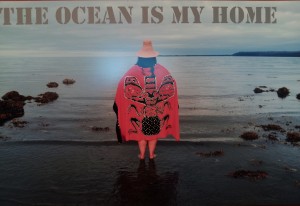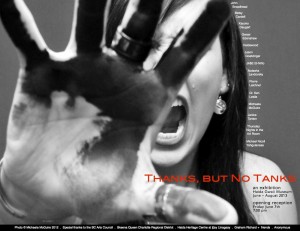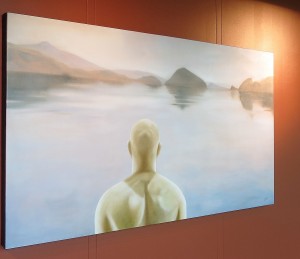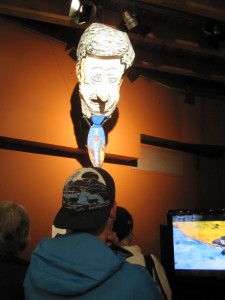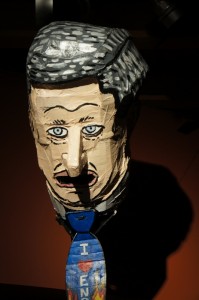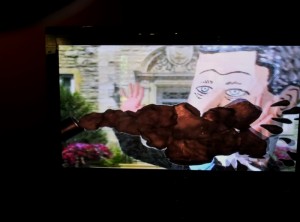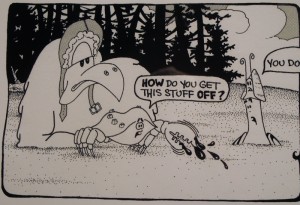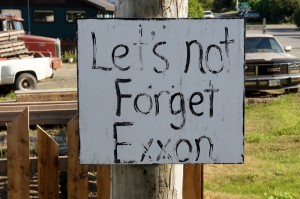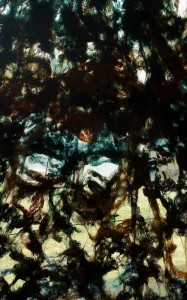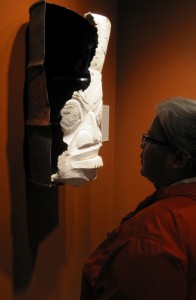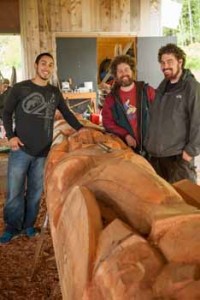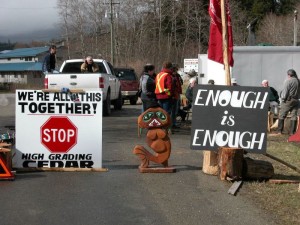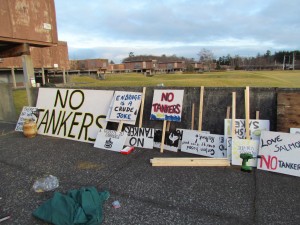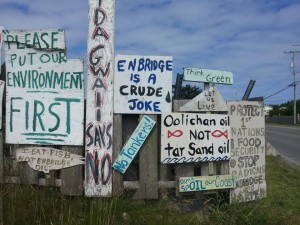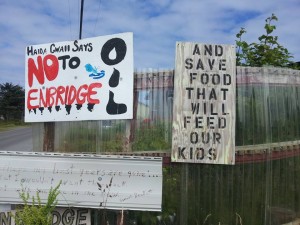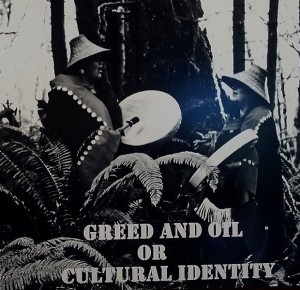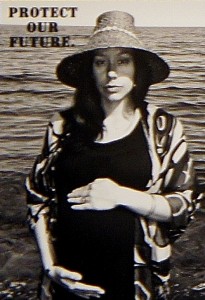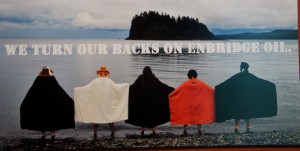Part II Haida Gwaii: Thanks, But No Tanks
Through the windows of the Haida Gwaii Cultural Center, the beach and sea and sky and birds beckon us to embrace the stunning land that belongs to the Haida people today and for the last ten thousand years.
Although their traditional communities were decimated by small pox in the late 19th century, and by 1900 the Haida were reduced to only 300 people concentrated in two villages Old Masset on the Northern end of Graham Island and Skidegate on the Southeast, these villages today are active centers of Haida culture.
In 1985 Bill C31 enabled First Nations peoples in Canada to regain their status, and Skidegate welcomed people to return. This summer everyone was thrilled with the raising of the Legacy Pole in honor of twenty years of joint management of the islands “from the bottom of the sea to the sky”with the British Columbia government.
In the windows of the Haida Gwaii Cultural Center, curator Nika Collison has placed a succession of quotations from the hearings by the Joint Review Panel Hearings about the Enbridge Oil Company Northern Gateway proposal to pipe bitumen ( heavy tar sands oil, diluted by toxic chemicals imported from China) from Alberta and send it by giant tankers through these delicate shorelines and seas. The hearings were held all over British Colombia as well as on Haida Gwaii in 2012.
Tribal leaders testified eloquently, pointing out that the project failed to accurately measure the risks: “Northern Gateway does not appear to understand the responsibilities that flow from being inextricably linked with the natural environment.” (as quoted in the Haida Lass, Newsletter of the Council of the Haida Nation.) If you want to see the propaganda for the project from Enbridge you can read it here. They even have a link titled benefits for aboriginals, which gives them a ten percent share!
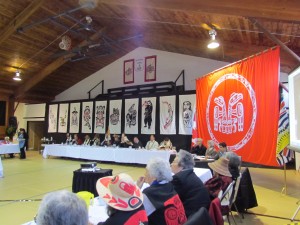
Hereditary Leaders at Enbridge Hearing on Haida Gwaii Image courtesy of Haida Laas newsletter of the Council of the Haida Nation
Collison alternates quotes between tribal leaders and other opponents with the words of the oil company. In this particular setting we can sense the absurdity of the oil companies’ perspectives to their fullest. We can understand the deep divergence of the two mind sets, one offering “jobs”and “economic opportunity” the other saying the land, sea and sky’s health is more important.
The quotations provide the entrance to “Thanks, But No Tanks,” 25 striking works of photography, animation, cartoons, paintings, and sculpture by both native and non native artists that all protest the pipelines and tankers.
A young woman named Michaela McGuire was so affected by the hearings that she decided, as an amateur photographer, to make images about the significance of the threat of the tankers to Haida culture. The result was a series of staged photographs (developed in a collaborative workshop) with Haida youth, men and women wearing traditional regalia, standing by the sea or in the forest, with a brief text which brings home the meaning of the destruction of these lands for Haida people. ”
In addition, McGuire created a potent self portrait of her oil-soaked hand reaching out toward the camera, her screaming face visible through her fingers.
As curator Collison told me: “the strength of the photos catalyzed the show.”
Another dramatic response to the threat of the tankers came from Janice Tanton who had supported herself comfortably with sales to patrons from the oil community. When she came to Haida Gwaii for a residency, she completely changed her mind, and chose to oppose the project.
Her striking painting of “everyman” gazing out over Alliford Bay is one result of her distress. As she crossed Alliford Bay on a small ferry she was crossing over not only physically, but also emotionally and mentally, to another way of understanding the world. It is easy to understand this change: these islands exert a magnetic force.
Hanging from the ceiling in one room, is a paper mache head of Canadian Prime Minister Stephen Harper. It is one prop for a multimedia video called “Haida Raid 2: A Message to Stephen Harper.” an animated video that includes a rap song performed by JA$E El-Nino that begins:
“I met a Native man that did a span in Afghanistan
He even toked hash with a clan of the Taliban”
The animation by Haidawood includes Raven reprogramming the computer so that the oil is redirected into Stephen Harper’s face.
The curator also included a 1977 cartoon book Tales of Raven, no1 No Tankers, T’anks . Michael Nicoll Yahgulanaas and John Broadhead
created it to oppose a previous disastrous project bringing the Exxon Valdez oil through Hecate Straits (the body of water between the BC mainland and Haida Gwaii- aptly named after the Greek Goddess associated with crossroads, entrance-ways, fire, light, the Moon, magic, witchcraft, knowledge of herbs and poisonous plants, necromancy, and sorcery.)
That protest successfully moved the Exxon Valdez project to Alaska, and we all know what happened next, an oil spill that has still not been cleaned up. Leaking tar sands out of old tankers could never even be cleaned up at all, so thick is the tar coming from the Alberta fields.
Among the many hand painted signs all over Haida Gwaii protesting the tankers was this one
Kayoko Daugert was accustomed to making joyful watercolors of nature, so this dark subject was a challenge for her. Catching Swarms of Invasive False Promises is a delicate watercolor that appears to be lighthearted until you look closely and see that the children are picking up globs of tar from the beach.
Photographs by Natasha Lavdovsky looked at underwater life, Pierre Leichner created tableux of toy soldiers in a delicate marine environment, possibly futilely trying to clean up, or suggesting that the tankers are like a war on the world under the sea.
Betsy Cardell’s hanging felted wool appears to have been eaten away by toxins; a big multimedia sculpture created collaboratively by 11 artists suggests all the forms of life under the sea :”The forest and ocean conceal little known secrets. While we sleep a symphony of cacophonous life explodes – if we don’t hear it, does it exist? Invisible, palpable, ruckus, rich . . . ”
One of the striking works in the exhibition is by Gwaai Edenshaw.
Hollow Promises: Two Hundred Years of Pain and Exploitation is cast of a fragment of a face mounted on a rusty oil can. Edenshaw’s work addresses the theme of prostitution: oil boom territory leads to a 600 percent increase in transient workers and transient prostitution. This ragged face exposes those ravages. I also read the piece as a reference to the renewed threat to the Haida from the tar sands tankers. It is accompanied by a short poem:
A hollow torn form smudged with greasy fingers.
A worn soul under the heel of “away from home”
The price of money . . . we cannot bear it.
The price of oil we will not carry it.
The irony is that at the same time as the exhibition, the Haida were creating the legacy pole honoring twenty years of cooperative management protecting Gwaii Haanas from the bottom of the sea to the top of the sky. Gwaai Edenshaw, was an assistant along with Tyler York, on the Legacy Pole with lead carver Jaalen Edenshaw. At the dedication, the Haida declared their “responsibility to conduct ourselves in a way that honors our ancestors.” Since those ancestors have recently offered fierce and successful resistance to destruction of their land, we know what to expect next if Enbridge continues.
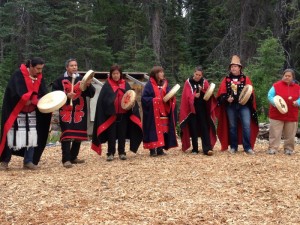
Greeting resistors to Unist’ot’en Camp established on the line of the Northern Gateway pipeline 2013
Already there are mainland first nations camping on the route of the pipeline.
The plan is to fight in the courts because the First Nations have never given up their lands in treaties in Canada and they still have title to their land. But Stephen Harper, as Prime Minister, is doing everything he can to turn back the clock and take away indigenous rights, while talking as though he is providing economic progress. Raven’s action in turning the pipeline programming so that the tar sands squirts right in Harper’s face is a great idea. But Haida will be fighting with their bodies, minds and spirits, as will other First Nations groups, alongside US based tribes and many other groups who are also fighting the tankers and tar sands pipelines across the continent.
Stephen Harper is trying to “reset” the relationships with First Nations, meaning apparently to revoke their rights under cover of providing increased “opportunity.” The absurdity of these opportunities, to allow the complete destruction of the land in return for some temporary jobs in a toxic environment, is obvious from the vantage point of Haida Gwaii.
This entry was posted on August 28, 2013 and is filed under Art and Ecology, Art and Politics Now, art criticism, ecology, economic imperialism vs democracy, First Nations Art, Gulf Oil Spill.

